NorthBay biz visits four outstanding small producers in Napa and Sonoma counties.
GlenLyon Vineyards & Winery
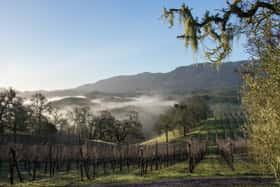 By Sarah Treseler
By Sarah TreselerPO Box 1329
Glen Ellen, CA 95442
(707) 833-0032
Case production: 1,000-1,400
Planted acres: 7.5
Grapes used: Syrah, Cabernet Sauvignon, Viognier and Chardonnay
Wines produced: Two sparkling wines, Rosé, Viognier, Chardonnay, Cabernet Sauvignon, Syrah, Port, Mistelle, Mistelle Rouge, and two red blends.
Employees: 2
GlenLyon Vineyards and Winery is situated deep in the hills of Glen Ellen, hidden among the mist and oak forests. It’s a tricky place to find, but once discovered it showcases many of the aspects that make Sonoma special. Owners Squire and Suzy Fridell, who live on-property, are more than willing to share their stories—and they have plenty.
Squire Fridell, who serves as vineyard manager, winemaker and janitor, came to the craft in a less than traditional fashion. Up until about five years ago, he worked as an actor, and as a consequence, he spent many years in Southern California. Back in the day, Fridell was under contract to Universal Studios. “I used to do all those old television shows and be loaned out every week to do a different show,” he says. “I was also quite good at television commercials. I’ve probably done more than anyone else—about 3,400 of them.” The entryway in the family home bears witness to this particular part of his life, with his photo on the cover of TV Guide magazine and his name featured in a Variety magazine crossword puzzle.
However, after the birth of his daughter, his views on living began to change. “We had a little girl in 1982; she’s our only child,” Fridell says. “We lived on the beach in Sunset Beach. I finished a job one day and Suzy and I were watching the sun go down over Catalina Island. We looked down to the sand in front of us and there were a bunch of 14-year-old boys smoking dope and drinking beer. I looked at her, we looked at our little baby crawling along on the floor, and we decided it wasn’t the perfect place to raise our family.”
When visiting Fridell’s father in the Santa Rosa area in 1984, the family discovered 26 acres of raw land in Glen Ellen, bought it and built a cottage, living there for a year until their big house was finished. After a string of roles in different commercials, Fridell won the role of Ronald McDonald from 1984 to 1991. “The day I signed that contract was the day we put our beach house on the market and physically began to move up to Glen Ellen,” he says proudly. They moved up in 1986, planted their first vineyard, sold grapes and made “home wine.” GlenLyon Winery was officially established in 1997.
The name for the vineyards and winery came from a combination of ideas. Suzy is of Scottish origin and her family crest features a wild boar. “When we bought this property, there were wild boar rooting everywhere here, so that seemed to fit [for our logo],” Fridell says. “And then we discovered her family was from the Glen Lyon region in the highlands in Perthshire—and we live in Glen Ellen. So we decided to call it GlenLyon.”
Fridell has two wineries, GlenLyon, and more recently a second, Two Amigos, which he co-owns with his best friend from college, Bob Briner. Fridell explains, “I was selling grapes to a winery that was sold to Constellation Brands. All of a sudden, I was no longer selling grapes to my friend, I was selling grapes to guys in three-piece suits. They weren’t farmers, they didn’t understand the farming mentality.”
Briner proposed that, instead of selling grapes, they could start another winery, together. They began it five years ago. The wines are labeled separately, but it’s all still the same wine.
GlenLyon (and Two Amigos) wines are fruit forward, in part because Fridell chooses stainless steel fermentation for all his grapes as opposed to barrel fermentation. After barrel fermenting for 25 years, he now feels steel fermentation suits his style better for a multitude of reasons. For starters, he says, barrels breathe and necessitate topping off every two weeks to avoid oxidization. “Why in God’s name would you put wine inside of a vessel that’s going to atmospherically leak?” he asks.
Secondly, the barrel naturally sucks in air, which Fridell says softens the taste and thus takes away from some of the individual flavor of the wine. “To have little mini droplets of air circulating through there smoothes out those wonderful things that makes the wine distinct.”
Lastly, when the wine barrels are toasted, the sap in the wood rises to the surface and the sap caramelizes. Fridell explains, “So if you ever get say a Chardonnay that’s seen a lot of oak and you smell caramel, butterscotch, vanilla, that’s the barrel, not the wine. If you get a red wine and you get that pleasant sweet smell of an empty cigar box, coffee, chocolate or cocoa—that’s pretty much the barrel.”
Not to say that this is a bad thing, it’s simply a matter of choice. “How much wood do you want to have in your wine? That’s entirely up to the winemaker,” he acknowledges. “I don’t like to smell or taste the presence of oak. To me, it hides the fruit—and as we all know, I’m a fruit forward kind of guy.”
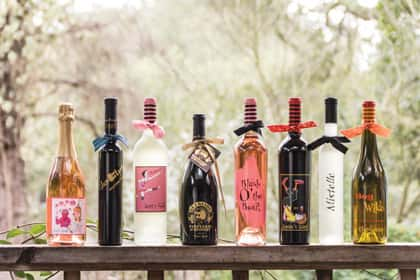
True to his word, the wines are light, gentle and crisp on the whole, made in the French style, without heavy edges or spices. They’re flavorful without being overwhelming, and partner Bob Briner notes that the Rosé, Viognier and even the Chardonnay are easy to pair with appetizers, while still maintaining a fresh, inviting mouthfeel.
The Port was a particular treat, made with pure grape spirits and no brandy overtones. Briner recommends pairing it with milk chocolate, to add to the flavor.
Both the vineyards and wineries are sustainable and there are no plans for expansion. Fridell is careful to give credit where it’s due, adding “I have to give credit to all of the winemaking masters who taught me how to make wine—there have been many over the years. One thing I think is neat about not being Cal Davis educated, is that I learned from masters.”
Gamble Family Vineyards
By Christina Julian
7554 St. Helena Highway, Napa 94558
(707) 944-0670
Case production: 8,000-9,000
Planted acres: 175
Grapes used: Chardonnay, Pinot Noir, Syrah, Sauvignon Blanc, Petite Sirah, Cabernet Sauvignon, Petit Verdot, Cabernet Franc and Merlot.
Wines produced: Sauvignon Blanc, Cabernet Sauvignon, Syrah, Petite Sirah, Cabernet Franc, Paramount Proprietary blend
Employees: 9 full-time
For Tom Gamble, owner of Gamble Family Vineyards, farming is in his blood with family roots that date back to 1916, when grandfather Launcelot arrived in Napa Valley. While this year marks the family’s 100th year of farming here, wine wasn’t always the “chosen one”: “My grandfather followed his brother here, who was mining quicksilver during the Robert Louis Stevenson days. But livestock was my grandfather’s passion.”
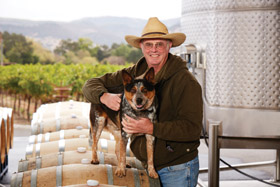 At one point, Gamble’s grandfather had accumulated as much as 20,000 acres around Lake Berryessa and Oakville. Today his father George continues Launcelot’s tradition steering cattle, while Tom and his wife, Colette, manage 175 vineyard acres (the family leases 900 acres to Beringer). “It was part of what we had to do to keep the land when [Launcelot] died. We stand on broad shoulders. Our family acquired the land and sacrificed to keep it.”
At one point, Gamble’s grandfather had accumulated as much as 20,000 acres around Lake Berryessa and Oakville. Today his father George continues Launcelot’s tradition steering cattle, while Tom and his wife, Colette, manage 175 vineyard acres (the family leases 900 acres to Beringer). “It was part of what we had to do to keep the land when [Launcelot] died. We stand on broad shoulders. Our family acquired the land and sacrificed to keep it.” As a third generation farmer charged with tending vineyards, Tom looks every bit the part with his cowboy hat and blue heeler, Koa, in tow. He speaks fondly of his childhood in the valley while noting some of the changes. “We can’t ride our 10-speeds to school with our 22s on our backs, and we can’t ride our horses along Highway 29 anymore.”
Gamble purchased his first vineyard in 1981 and remains as committed to the land as his forefathers. “We’re fortunate to have the Ag Preserve and the subsequent legislation,” he says. “Sure, it’s created some challenges, but we wouldn’t have the agricultural lands and open space like we do now—it would be more like Silicon Valley.”
In 2013, Gamble built the winery as a means for optimizing wine quality. “It lets us control things in a way we couldn’t in a custom crush facility.” The tasting room, which serves guests by referral only, opened in 2014.
Gamble talks about the lessons he learned early on from mentors Chuck Carpy and Jack Davies, and the inspiration he drew from Robert Mondavi: “For them, it was always about quality and sustainability. Paying growers a fair price. Taking care of people. We’re always learning how to take better care of our land.”
Diversity reigns
Gamble seems undaunted by the complexities that could come with managing 175 acres of vines with soil types that can differ from one end of the row to the next. “That’s where the fun comes in,” he ays. “Micromanaging down to all the different soil types, vine and root stock selections. It’s about balance. Our goal is to have fully flavored grapes at lower sugars, which means managing vine canopy and yield to be in balance with each other.”
On our lengthy tour around the family’s vineyards from Oakville to Yountville, we make a pit stop at a section of Sauvignon Blanc. He points to what he calls the “poodle dog leafing technique”: “We’re not only leafing around the grapes but higher up in the canopy along the hedging to manage how fast the grapes ripen. If you have too few grapes for the vigor of the vine, they’ll ripen too fast. If there are too many grapes near the leaf or the vine, they may never get ripe. We look to manage yield in relation to the health of the vine.”
Despite no longer being able to ride horses down Highway 29, Gamble sees value in the fruits that the passage of time bears. “Fifty years ago, we didn’t have the rootstock selections that are out there now. You couldn’t plant certain properties with certain varieties because they just wouldn’t do well. But now we’re learning how to make great wines with soils that, 50 or 60 years ago, were considered only suitable for pasture.” Gamble also sees the advancements in technology as beneficial. “Mechanical harvesters weren’t good for high-end winemaking 30 years ago, but now they can often pick cleaner than hand harvesters. I’m sure there were once people who poo-pooed the tractor, but it changed everything.”
As intrigued as he is by the potential that further mechanization could bring, he feels one aspect of vineyard management should never change. “You always have to put your boots on out there in the vineyard and pay attention. We spend a lot of time in the vineyard so we can come out with something good in the winery.” With generations of farming behind him, Gamble continues to pour a great deal of energy and heart into every glass of the family wine—another point that isn’t likely to change.
Monticello Vineyards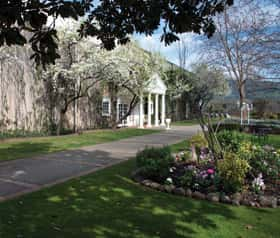
By William Rohrs
4242 Big Ranch Road, Napa, 94558
(707) 253-2802
Case production: 15,000
Planted acres: 100 acres over five properties
Grapes used: Cabernet Sauvignon, Cabernet Franc, Merlot, Syrah, Chardonnay, Pinot Noir
Wines produced: Chardonnay; Pinot Noir; Cabernet Franc; Merlot; Syrah; Cabernet Sauvignon, Jefferson Cuvee; red blend
Employees: 30, depending on the season
“Jay Corley, our father, bought a dilapidated prune orchard in the 1970s,” says Stephen Corley, director of wine sales and marketing (and one of seven children) of the Corley Family Napa Valley Monticello Vineyards founder. “Where once stood a field of dirt, dad saw a field of dreams. When he came to California, he wanted to plant vineyards and make wine—And a dilapidated prune orchard was where he started.”
Jay Corley, retired at 38 years old from several business ventures in Southern California following a public service position in Arlington, Va., had two things on his mind when moving north to Napa valley: wine and Thomas Jefferson. Inspired by the statesman’s voracious appetite for wine, Corley planted Pinot Noir and Chardonnay vineyards and went to work. Today, Monticello Vineyards, managed by brothers Kevin, Stephen, Chris and Kent Corley continues their father’s legacy (Jay Corley passed away in January 2016.)
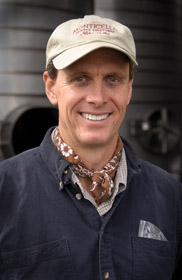 The property on Big Ranch Road is inspired by its namesake’s estate: Jefferson’s Monticello, built in homage of the former president’s house. The tasting room across the walkway from the house sports the Colonial style of Monticello as well. Patios and garden seating are available to tasters, and speakers installed on the outer walls provide music to listen while you sip. The charming property takes people away from the busy Silverado Trail less than a mile away, teleporting tasters to the Corley’s world, which features idyllic surroundings and excellent wines.
The property on Big Ranch Road is inspired by its namesake’s estate: Jefferson’s Monticello, built in homage of the former president’s house. The tasting room across the walkway from the house sports the Colonial style of Monticello as well. Patios and garden seating are available to tasters, and speakers installed on the outer walls provide music to listen while you sip. The charming property takes people away from the busy Silverado Trail less than a mile away, teleporting tasters to the Corley’s world, which features idyllic surroundings and excellent wines.Jefferson’s history was definitely a factor in shaping the Corley legacy, but it was the sweat on the brow of Jay and his children that cemented it. “Dad always worked hard, and ever since we were kids, we learned how to work in the vineyards, too,” says Stephen. “He always envisioned this being a family business.”
Fiscal prudence and hard work from the family kept the winery afloat in the early years. Stephen and Kevin still use a vineyard forklift their father purchased used in 1970, “and everyone was telling him he was being silly because that tractor already had years and years of service on it before we bought it,” laughs Kevin. “But dad and the other staff took good care of it, and that antique is still a workhorse on our vineyard today.”
 The Corleys aren’t strangers to new techniques, either. They’ve followed the latest techniques in enology, fermentation practices and soil analysis with a true respect for terroir. “I believe terroir is a very real concept,” says Kevin. “It is meaningful enough to us that we produce multiple vineyard, block and clonally designated wines and label them precisely for what they are. It’s a very intimate way of letting our tasters know exactly where their wine comes from.”
The Corleys aren’t strangers to new techniques, either. They’ve followed the latest techniques in enology, fermentation practices and soil analysis with a true respect for terroir. “I believe terroir is a very real concept,” says Kevin. “It is meaningful enough to us that we produce multiple vineyard, block and clonally designated wines and label them precisely for what they are. It’s a very intimate way of letting our tasters know exactly where their wine comes from.”Corley family wines are available in 14 states and four foreign countries. “One of the most amazing moments we’ve ever had was in Wales in 1987,” Stephen says. “After dinner in a local restaurant my brother Michael and I were invited by the wait-staff to a wine bar across the street. The bar was packed because it was one of the only places open at that hour. I was trying to flag down a bartender for a drink when I noticed a bottle of wine. I picked it up and it was one of our Monticello Vineyards Estate Grown Chardonnays. I was ecstatic!” As it turned out, the owner of the wine bar had just received his shipment that day had just tasted the wine that evening. The Corleys put Jay on the phone and became friends with the owner. Jay and his wife spent time with the owner’s family in 1994 when they visited Wales to meet in person.
“That’s what being a part of the Corley family means to me,” Kevin says. “And I mean ‘family’ as in the community that continues to support and care for us. In the early days, whenever we had a question about winemaking, other wineries were quick to give us advice and insights and today we get to share our experience with newcomers and old-timers as well. We have 11 employees that have been working for us for more than 20 years, four over 30 years, and they don’t have Corley in their names. That’s the loyalty and legacy that our father made for us, and it’s our honor to carry it in his name.”
Merriam Vineyards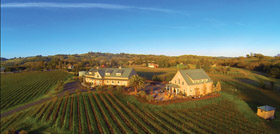
By Sarah Treseler
11654 Los Amigos Rd, Healdsburg, CA 95448
(707) 433-4032
Case production: 3,000
Planted acres: 18
Grapes used: Cabernet Sauvignon, Merlot, Cabernet Franc, Petit Verdot, Pinot Noir, Sauvignon Blanc, Sémillon
Wines produced: Cabernet Franc, Cabernet Sauvignon, 2 red blends, Merlot, Malbec, Petit Verdot, Sauvignon Blanc, Rosé, Pinot Noir, LH Sauvignon Blanc, Sparkling Blanc de Noir
Employees: 4 to 7, depending on the season.
In Wine Country, great things often come from small places. Such is the case at Healdsburg’s Merriam Vineyards. Established in 2000, it’s unobtrusively making a name for itself with vintages that have won gold at competitions including the North Coast Wine Challenge, San Francisco Chronicle Wine Challenge, and Sonoma County Harvest Fair among others. Located on 24 bucolic acres, there’s an immediate sense of peace about the place, a gentle stillness perfect for cultivating relaxation along with wine.
Proprietor Peter Merriam hails from the East Coast and started in the wine business outside of Boston, Mass. He recalls, “Some of my friends moved out to [the North Bay] Wine Country and went to work in various wineries. I came out and visited the area for work.” Impressed by the beauty of Sonoma County, Merriam was inspired to plant vineyards and build a winery of his own in the Russian River Valley. He looked for land from 1995 to 1997 and together with his wife, Diana, purchased their first vineyard on Limerick Lane in 2000. The winery was completed in 2008.
Merriam Vineyards’ approach to its wine is compassionate and attentive. Says winemaker David Herzberg, “Peter is very involved. Each time he comes out, he walks the vineyards.”
Merriam also oversees the blending trials with Herzberg, where the two gather to evaluate each individual blend four times per year. They each taste the wine and make decisions about color, flavors and varietal balance, among other issues.
As to what makes their vineyards special, Herzberg reflects, “We have Pinot Noir on the eastern side of the Russian River Valley, which not a lot of people have. We’re right in the same niche as some of the extremely well-known vineyards. We get the fog in the morning, though it still gets warm enough here to make Bordeaux style wines as well.”
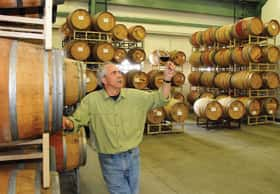 When harvesting the grapes, they keep it simple. “We take off clusters that are behind in ripening or don’t match up to the other grapes. Harvest is a very gentle process as we’ve already done most of the work in the vineyard.” Herzberg details. “We have all hand punch downs and let the vineyard express itself really gently.”
When harvesting the grapes, they keep it simple. “We take off clusters that are behind in ripening or don’t match up to the other grapes. Harvest is a very gentle process as we’ve already done most of the work in the vineyard.” Herzberg details. “We have all hand punch downs and let the vineyard express itself really gently.”Herzberg grew up in the Healdsburg area and was already working in the wine industry when he first visited Merriam Vineyards. He hit it off with the owners, saying that they were friends first, but quickly became like family. “The founders are very family-oriented,” he explains.
Merriam Vineyards models traditional French farming and winemaking, with its wines influenced by Bordeaux and Burgundy styles. It also has a commitment to sustainable farming practices such as water reclamation and composting systems. All the estate winery is organic, and both estate vineyards are sustainable. There are no current plans for expansion.
The wines tend to echo the care they’ve been given, with many of the vintages displaying a satisfying complexity in taste, while still retaining soft mouthfeels and notably balanced finishes.
The wines themselves are available online or through the wine club, delivered directly to the consumer. Events are posted on the website, including A Wine and Food Affair and Tasting Along the Wine Road.
“We just try and do the best we can, using minimal influence and letting the fruit speak for itself,” says Herzberg. “Working with the changes in the weather, no matter what.”



